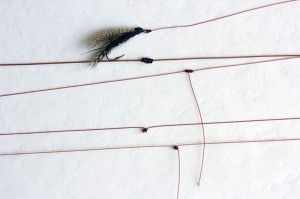Albright Knot, Arbor Knot, Bimini Twist, Blood Knot, Dropper Loop, Duncan (Uni) Knot, Improved Clinch Knot, Palomar Knot, Perfection Loop, San Diego Jam Knot Surgeon’s Loop. There are more than 30 different knots that a fly fisherman can use for attaching lines, leaders, tippets and flies. All of them have a reason for existence but not all of them work under all conditions. In all the years that I have been flinging a fly line I have tried many knots that have been recommended by some famous writer or guide.
I am a hunter as well as a fisherman. Years ago I stopped hunting deer. My reasoning was simple. The decoys were too heavy and the dog wouldn’t retrieve them. With advancing years and a growing desire to avoid complications I have decided to simplify my fishing life by picking a couple of knots and learning their strengths and weakness. It sure does help simplify things. Here are my favorite knots for my style of trout fishing. Saltwater and Steelhead knots are future topics. You can develop your own, but my decisions are based on ease of use, utility and reliability.
1. Fly line backing to the reel : The Arbor Knot is an easy knot to tie and, besides, how many times do you tie one of these ?
2. Backing to fly line and fly line to leader (if you are adding a butt section for a leader to line loop or knot connection): The Albright Knot is a little tricky but is easy with practice. When tied, it has an advantage in that the line(s) come out of the center of the knot helping them flow easier through the guides. Coating the knot with a flexible cement like Pliobond helps stop the knot from hanging up in the guides.
3. Loop to loop leader connection: I now prefer a loop to loop connection to the leader using either the “Chinese Finger Puzzle” line connectors or the newer end loop splicing that is available on today’s fly lines. They make changing leaders a lot easier. A Perfection Loop or Surgeons Loop works well. You still have to use a real knot with double taper lines or specialty line riggings, but that a whole topic by itself.
4. Leader line or leader to tippet connections. Even if you use modern tapered leaders, you still have to attach the leader and tippet. If you have to replace some of the leader or want to extend it, you will have to tie some type of knot to do this. I prefer the blood knot. It takes a little time but has been the most reliable connector for me for years. I like to make up my own leaders so it is my knot of choice. I also fish two fly rigs and a blood knot dropper, again, has worked well for me over the years. If I’m in a hurry or in dim light I prefer a surgeon’s knot since it is quick and easy. You can use a dropper with this knot also. The main disadvantage of the Surgeon’s Knot is that it puts a lump in the leader which tends to pick up dirt and debris.
5. Tippet or leader to fly connection: Here is where the rubber meet the road so to speak. You can do all of the above knots correctly but if you use a poor knot here, you have wasted all your effort. The Uni-knot, Turle Knot and numerous others can work. I prefer to keep it simple and use an Improved Clinch Knot. With the proper number of wraps and wetting it before you tighten it down it has performed well for me for years. It is sometimes hard to get the line back through the loop ( I blame age) but it works. It is also a pretty good knot if you prefer to fish a dropper nymph off of an indicator fly.
There you have it. While these are the knots that have consistently worked for me, there are many others that you may prefer. If you follow the guideline of ease of use, utility and reliability you will attain fishing success.
Je demande un avantage injuste



